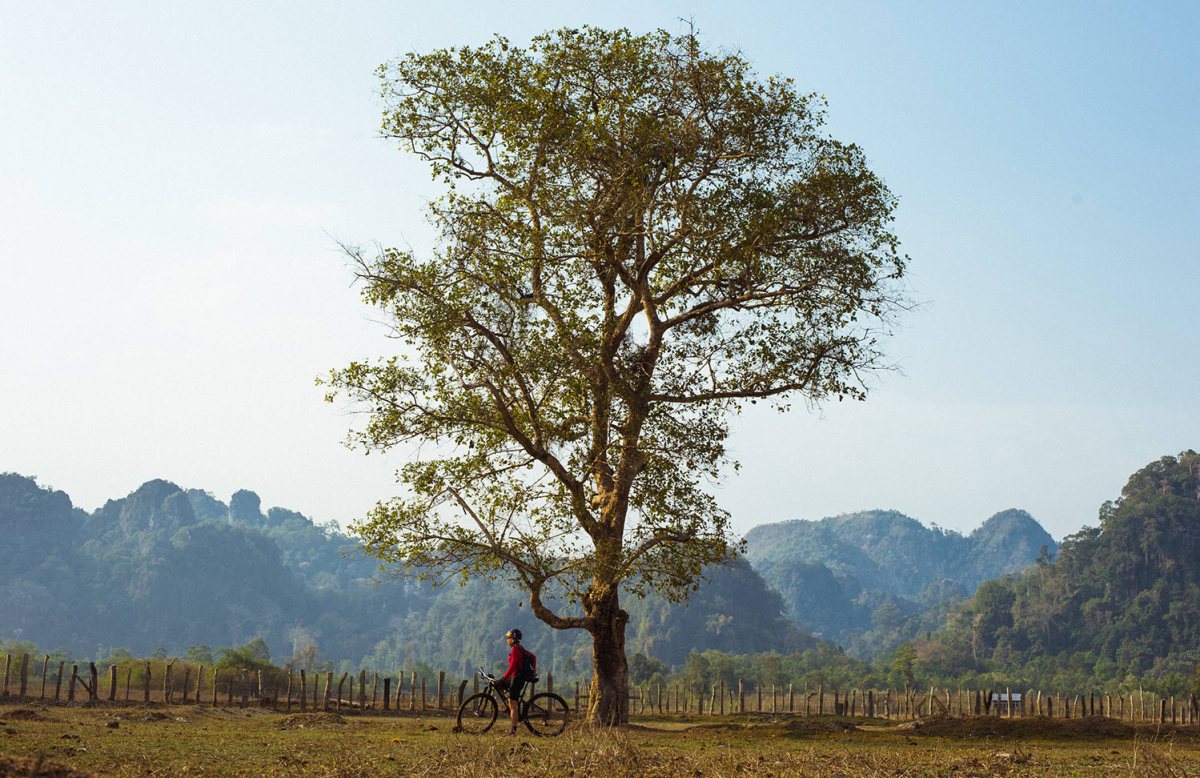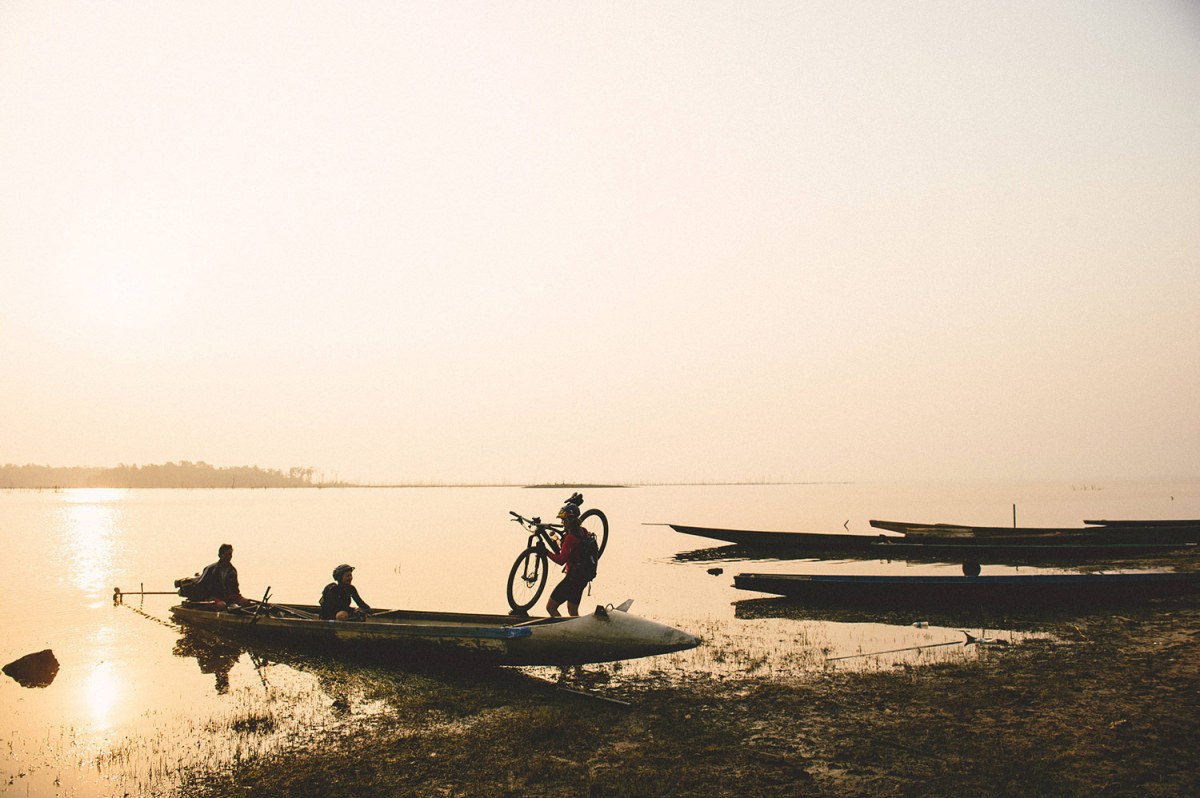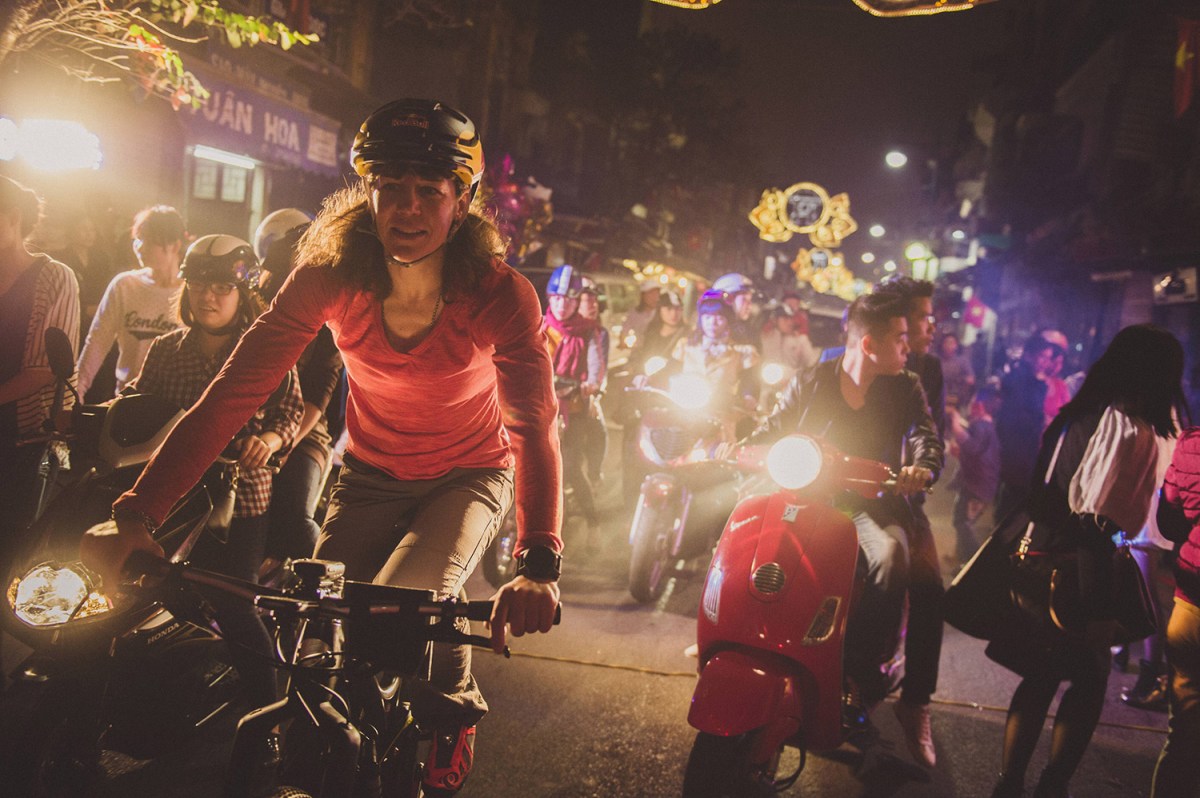A Q&A with mountain biking’s “Queen of Pain”
Rebecca Rusch is many things to many people. She’s a seven-time world champion mountain biker and a four-time Leadville 100 winner. She’s a decorated adventure racer and has claimed a first female ascent on Yosemite’s El Capitan (yeah, seriously). She’s a volunteer firefighter, an activist and a role model.
What Rusch has accomplished in her 48 years—both athletically and otherwise—is nothing short of inspiring. Eat your heart out, Wonder Woman.
But a new documentary, Blood Road, makes it very clear that Rusch is one more thing: A daughter. More specifically, she’s a daughter who grew up without ever knowing her father. He was killed during the Vietnam War when his fighter jet was shot down over the Laos jungle. Over 30 years later, in 2003, her father’s remains were identified and with them, the exact coordinates of his plane’s crash site.
In search of closure and of her father’s final resting place, Rusch set out in 2015 to ride the entire 1,200-mile Ho Chi Minh Trail—also known as the “Blood Road”—through Vietnam, Laos and Cambodia. Blood Road captures Rusch’s expedition, which challenged her in new ways, opened her eyes to the living history of the Vietnam War, reinforced the meditative power of cycling and left her with a newfound sense of purpose.
In the midst of a national tour and on the eve of the film’s full release, I caught up with Rusch to talk about pain, the film and why riding continues to be such an important part of her life.
Why the affinity for such long, arduous bike adventures like this one? Do you enjoy pain?
In high school, I ran track, but a precise four laps around a track of exactly the same distance—I wasn’t mentally engaged, so I think that’s why I like these really long, unpredictable things. Because I don’t know what’s going to happen and I like having to figure it out as I go.
Plus, you get to see somebody’s true colors when you’re lost and you’re sleepy and you’re hungry and you’ve been going for seven or eight hours. I feel like the defense layers that we put up—of who we think we are—those are all stripped away and you’re just really who you are.
So, no, I don’t like being in pain, but I like who I am on the other side of it. On the other side of something really, really hard, I’m always going to come out with a win in one way or another and I grow as a person every time. The Ho Chi Minh Trail ride is one example of where I sort of thought I’d done everything, but here I go on this ride, and it completely changed me.
Your trophy case and adventure résumé are more than impressive. What’s your proudest achievement?
Well, two things.
First, this ride on the Ho Chi Minh Trail is the most important thing I’ve done in my life, absolutely. It was the culmination of my expedition experience combined with racing and a personal story. I’ve spent my whole life preparing for it. All of the sports I’ve done that may seem sort of random and not connected in any way—even whitewater and rock climbing [laughs]—came into play on this trip, so I’m super proud of that.
The second thing is probably my longevity as an athlete—being able to continue making a living at the things I’ve wanted to do and being able to stay healthy and do it for going on three decades.

Speaking of longevity, do you have any words of wisdom for the aging athletes among us?
One thing is that training really works. If you have a coach and you have consistency, you do intervals and you put the hard work in, no matter what age you are, it actually pays off. As a younger athlete, you can rely a little more on your strength and stupidity [laughs], but when you’re older, you need to train and maintain and stretch and actually take care of yourself. I started bike racing when I was 38, and it’s been really cool to see increased power numbers related to specific training—that it actually does work.
Another thing I’ve learned is related to having done a lot of different sports. I believe that if something makes your hands a little sweaty and you’re excited about it, then those are the right kinds of things to go after—and if that stops happening, maybe it’s time to make an adjustment.
Even if you’re 38, or whatever age you are, and somebody asks “Do you want to try rock climbing?” or “Do you want to try stand up paddleboarding?” the answer is “Yes!” You should always say yes. We do that as kids, but we don’t often do it as adults because we don’t want to look stupid, we don’t want to get hurt or we don’t know how. I think it’s important to keep that child-like curiosity alive—to be like, “I’m gonna look like a total idiot but I don’t care.”
You didn’t really dive into mountain biking until you were 38. What advice would you give someone who’s new to the sport or wants to take their riding to the next level?
To be forgiving of yourself—of the stuff you’re bad at. When I came into mountain biking, I was super bad technically. I was not a good rider. But what I was good at—what I focused on—was I knew I could go for a long time and I could take care of myself overnight. Going for 24 hours is actually a short race compared to where I came from in adventure racing.
So I really tried to elevate the things I was good at while forgiving the things I sucked at. In my first mountain bike races, I’d run all the technical sections—I’d get off my bike, run as fast as I could and then jump back on and really hammer the easy parts. So instead of just thinking to myself, “I suck at mountain biking,”—which I did, if I’m being honest—I was like, “Okay, how can I make up for lost time and really elevate my strengths?”
Nobody’s 100-percent, across-the-board bad at every aspect of something they try. You may be a cerebral listener or you may be really flexible or you may have a very scientific, technical mind that gets into the training and you can focus on that. So I think that looking for the good stuff to highlight and then working on the bad stuff really helps. For me, sucking at technical riding just meant riding with my boyfriend or people I trusted, spending time working on my weaknesses but not getting totally hung up on them.

Your adventure meter must be pretty dialed by now. How does riding the Blood Road compare?
Physically? It was 1,200 miles, which is the longest ride I’ve ever done, but it wasn’t a race, it wasn’t as fast as I could go and it wasn’t as long as I could go. Going all day, every day—that’s a familiar place for me to be so I could fall back on familiar things: I’m hungry. I’m lost. Machete through the jungle … whatever. It sounds really extreme but that’s my comfort zone.
Really, it was a much bigger challenge emotionally.
While the expressed goal of the expedition was to find your father, the film gives the impression that you found much more than that. What was your biggest takeaway?
I found myself. Everyone is always asking me why I do these things, or why I love pain, and I was able to answer that. I really found a purpose for my riding. I think my father brought me there, and I can look back at all the layers that have added up—me being an endurance athlete and eventually a bike racer and an expedition bike athlete—and that was all preparation for this trip.
And I came home with a new purpose: using my bike and my reach to help clean up land mines that are still there. There’s a ton of unexploded ordnance still in Laos, where my dad was fighting, and I didn’t really realize that. Being a racer or a professional athlete can be a selfish endeavor, or seem like that. But now, through making this film and helping to clean up the unexploded ordinances, it’s a way for me to still go on big bike adventures while doing stuff that really matters.
[Editor’s note: So far, roughly 20 square miles have been cleared of unexploded ordnance thanks to the film.]

Was this a new level of cultural immersion for you?
I always want to learn about a place, I want to read literature from a place, I want to interact with the locals but it’s not this full personal immersion of having a family connection and knowing that I’m spending time with people that my dad was dropping bombs on. These bomb craters are in some way part of my family history, too. Also, riding with a Vietnamese partner and seeing the country through her eyes—it was a much deeper dive.
Do you think it was important that you did it by bike?
100-percent! Sure, I could have taken a plane, driven pretty close to the trail, walked into the jungle and gone looking for these same crash coordinates, but the adventurer in me was like, “I don’t think anyone has ever ridden the Ho Chi Minh Trail. I want to ride it.” All that time leading up to looking for those coordinates is what allowed me to really spend time in the culture and to peel away my layers and my expectations and what I thought I knew about the Vietnam War. (They call it the American War.)
Seeing all the living history along the trail—like the bomb craters, bombs still being used as planters, talking to people who were alive during the war, people who lived in caves when the bombs were coming down—it really was a three-dimensional trip through history. So if I had just gone straight to the crash site without my bike, I wouldn’t have been as receptive to what was right in front of me.
I also feel like that ultra endurance stuff is my meditation—it’s my way of processing. I spent a lot of time talking into a voice recorder while I was riding down the trail, and then stopping and journaling. I had to do it by bike. Even after trying to find the crash site, the rest of the trail was just more time for me to process what we did discover and what we saw. I think if I had gone to the crash site and then gotten on a plane and went home, it wouldn’t have sunk as deep into my core.

What do you hope viewers will take away from the film?
I hope viewers get an understanding of what went on, of what different cultures are like and of forgiveness. I don’t think you truly can forgive people or a situation until you really understand it. As different as [American and Vienamese] cultures may seem, both sides really did suffer the consequences—and we still are to this day. Whether it’s veterans with PTSD or Laos villagers who are still living amongst bombs that could go off at any time, we all still have those wounds. So I hope it is a healing and forgiving message for people, regardless of their connection to the war. I feel like it’s a global message.
[Editor’s note: Quotes have been edited for length and clarity. All photos courtesy of Josh Letchworth, Red Bull.]
